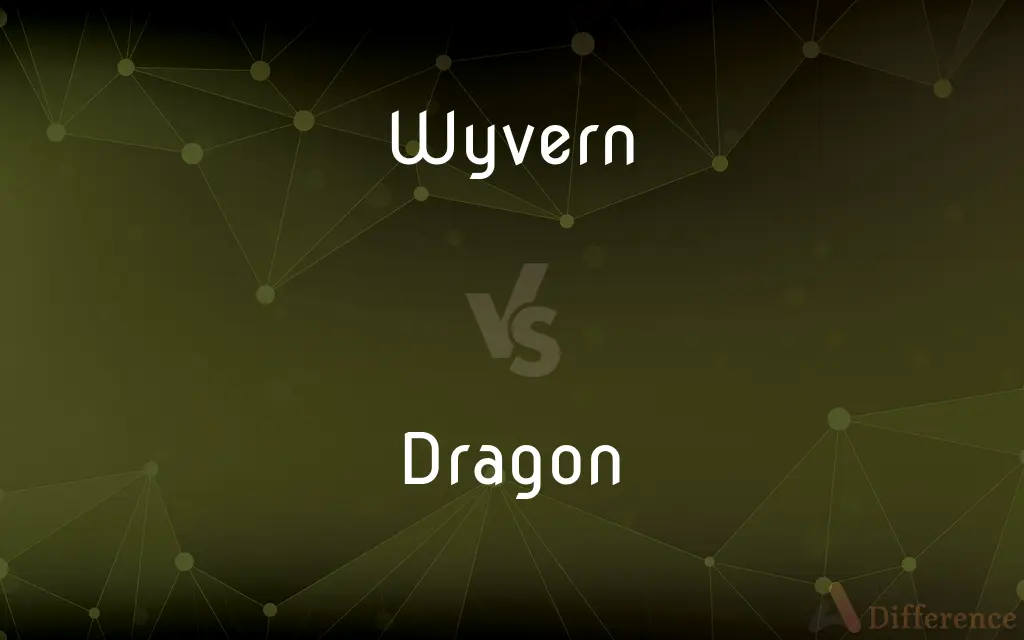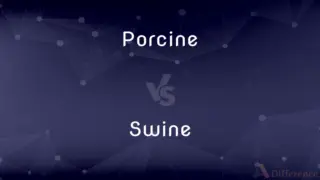Wyvern vs. Dragon — What's the Difference?
By Tayyaba Rehman — Updated on September 26, 2023
A wyvern is a mythical creature often depicted with wings and two legs, whereas a dragon is a legendary serpent-like creature, typically depicted with wings, four legs, and able to emit fire from its mouth.

Difference Between Wyvern and Dragon
Table of Contents
ADVERTISEMENT
Key Differences
Wyvern and dragon are mythical creatures found predominantly in European folklore and mythology, embodying different representations and symbolisms. A wyvern is usually depicted as a creature with a dragon's head, the body of a reptile, two legs, and wings, often symbolizing protection and strength. Its depiction in heraldry and other emblematic forms is fairly common, reflecting varying degrees of valor and guardianship.
Conversely, a dragon is a more versatile mythical creature, appearing in numerous cultures globally, with diverse portrayals ranging from winged, four-legged, fire-breathing entities to large, serpentine creatures. Dragons are complex symbols, often representing power, wisdom, and sometimes malevolence, with their interpretations and depictions varying significantly across different cultures.
Wyverns, despite their dragon-like appearance, are more defined in their anatomical structure, generally having a distinct representation with two legs and wings. They are less varied in their portrayals, usually maintaining a consistent representation across different folklore and mythology, serving as emblems of strength and guardianship.
Dragons, in contrast, enjoy a more flexible and varied representation, with their depictions ranging from benevolent, wise creatures in some cultures to destructive, malevolent entities in others. The multiplicity in dragon representations reflects the diverse cultural interpretations and symbolisms attributed to them, making them a more universally recognized mythical creature.
In essence, while both wyverns and dragons serve as powerful symbols in mythology, the wyvern has a more specified and less varied representation, primarily symbolizing protection and strength, whereas the dragon, with its multifaceted portrayals, symbolizes a broader range of concepts including power, wisdom, and malevolence.
ADVERTISEMENT
Comparison Chart
Legs
Two
Typically Four
Symbolism
Primarily Protection and Strength
Varies; Power, Wisdom, Malevolence
Representation in Folklore
Consistent, usually depicted with wings and two legs
Diverse, varies greatly among different cultures
Common Portrayal
Dragon’s head, reptilian body
Serpentine or Reptilian, often winged and fire-breathing
Cultural Variation
Less Varied
Extensively varied across cultures
Compare with Definitions
Wyvern
A legendary entity often representing protection and strength in European folklore.
The wyvern is seen as a guardian in many heraldic traditions.
Dragon
A creature typically represented as fire-breathing and winged, symbolizing destruction or wisdom.
The fierce dragon breathed fire, scorching everything in its path.
Wyvern
A mythical creature depicted with a dragon’s head and wings, and a reptilian body with two legs.
The wyvern on the coat of arms symbolized the protector of the realm.
Dragon
A versatile symbol in mythology, depicted either as benevolent or malevolent.
The dragon in this mythology is a wise and benevolent creature guiding the heroes.
Wyvern
A creature in mythology primarily featured in emblematic forms reflecting valor.
The knight bore a shield emblazoned with a wyvern, symbolizing his bravery.
Dragon
A creature with extensive varied representations across cultures, often associated with strength.
Dragons are revered in many cultures as symbols of strength and power.
Wyvern
An entity in folklore with consistent representation, symbolizing guardianship.
The wyvern is a revered symbol in our culture, representing steadfast guardianship.
Dragon
A dragon is a large, serpentine, legendary creature that appears in the folklore of many cultures worldwide. Beliefs about dragons vary considerably through regions, but dragons in western cultures since the High Middle Ages have often been depicted as winged, horned, four-legged, and capable of breathing fire.
Wyvern
A winged dragon with two legs, usually depicted as a defender or protector.
In the story, the wyvern was the loyal protector of the ancient treasure.
Dragon
See Draco2.
Wyvern
A wyvern ( WY-vərn, sometimes spelled wivern) is a legendary bipedal winged dragon usually depicted with a tail ending in a diamond- or arrow-shaped tip.The wyvern in its various forms is important to heraldry, frequently appearing as a mascot of schools and athletic teams (chiefly in the United States, United Kingdom, and Canada). It is a popular creature in European literature, video games, and modern fantasy.
Dragon
A mythical monster traditionally represented as a gigantic reptile having a long tail, sharp claws, scaly skin, and often wings.
Wyvern
A two-legged dragon having wings and a barbed tail.
Dragon
Any of various lizards, such as the Komodo dragon or the flying lizard.
Wyvern
A draconian creature possessing wings, only two legs and usually a barbed tail.
Dragon
A fiercely vigilant or intractable person.
Wyvern
Same as Wiver.
Dragon
Something very formidable or dangerous.
Wyvern
A fire-breathing dragon used in medieval heraldry; had the head of a dragon and the tail of a snake and a body with wings and two legs
Dragon
(Archaic) A large snake or serpent.
Dragon
A legendary serpentine or reptilian creature.
Dragon
In Western mythology, a gigantic beast, typically reptilian with leathery bat-like wings, lion-like claws, scaly skin and a serpent-like body, often a monster with fiery breath.
Dragon
In Eastern mythology, a large, snake-like monster with the eyes of a hare, the horns of a stag and the claws of a tiger, usually beneficent.
Dragon
An animal of various species that resemble a dragon in appearance:
Dragon
(obsolete) A very large snake; a python.
Dragon
Any of various agamid lizards of the genera Draco, Physignathus or Pogona.
Dragon
A Komodo dragon.
Dragon
The constellation Draco.
Dragon
(pejorative) A fierce and unpleasant woman; a harridan.
She’s a bit of a dragon.
Dragon
The (historical) Chinese empire or the People's Republic of China.
Napoleon already warned of the awakening of the Dragon.
Dragon
(figuratively) Something very formidable or dangerous.
Dragon
A type of playing-tile (red dragon, green dragon, white dragon) in the game of mahjong.
Dragon
A luminous exhalation from marshy ground, seeming to move through the air like a winged serpent.
Dragon
A short musket hooked to a swivel attached to a soldier's belt; so called from a representation of a dragon's head at the muzzle.
Dragon
A background process similar to a daemon.
Dragon
A variety of carrier pigeon.
Dragon
(slang) A transvestite man, or more broadly a male-to-female transgender person.
Dragon
A fabulous animal, generally represented as a monstrous winged serpent or lizard, with a crested head and enormous claws, and regarded as very powerful and ferocious.
The dragons which appear in early paintings and sculptures are invariably representations of a winged crocodile.
Thou breakest the heads of the dragons in the waters.
Thou shalt tread upon the lion and adder; the young lion and the dragon shalt thou trample under feet.
He laid hold on the dragon, that old serpent, which is the Devil and Satan, and bound him a thousand years.
Dragon
A fierce, violent person, esp. a woman.
Dragon
A constellation of the northern hemisphere figured as a dragon; Draco.
Dragon
A luminous exhalation from marshy grounds, seeming to move through the air as a winged serpent.
Dragon
A short musket hooked to a swivel attached to a soldier's belt; - so called from a representation of a dragon's head at the muzzle.
Dragon
A small arboreal lizard of the genus Draco, of several species, found in the East Indies and Southern Asia. Five or six of the hind ribs, on each side, are prolonged and covered with weblike skin, forming a sort of wing. These prolongations aid them in making long leaps from tree to tree. Called also flying lizard.
Dragon
A variety of carrier pigeon.
Dragon
A fabulous winged creature, sometimes borne as a charge in a coat of arms.
Dragon
A creature of Teutonic mythology; usually represented as breathing fire and having a reptilian body and sometimes wings
Dragon
A fiercely vigilant and unpleasant woman
Dragon
A faint constellation twisting around the north celestial pole and lying between Ursa Major and Cepheus
Dragon
Any of several small tropical Asian lizards capable of gliding by spreading winglike membranes on each side of the body
Dragon
A mythical creature often depicted as a large, serpentine entity, symbolizing power or malevolence.
The dragon in the legend guarded a vast treasure in the mountains.
Dragon
A legendary creature appearing in many cultures with varying representations and symbolisms.
In Eastern culture, the dragon is often seen as a symbol of wisdom and benevolence.
Common Curiosities
Can dragons symbolize both wisdom and malevolence?
Yes, depending on the culture, dragons can symbolize wisdom, malevolence, or other traits.
Are dragons usually depicted as fire-breathing creatures?
Yes, many cultures depict dragons as fire-breathing creatures.
Do wyverns primarily symbolize protection and strength?
Yes, wyverns primarily symbolize protection and strength in various mythologies.
Are dragons depicted as large, serpentine entities in some cultures?
Yes, in some cultures, dragons are depicted as large, serpentine entities symbolizing various concepts.
Is the representation of wyverns consistent in folklore?
Generally, yes, wyverns have a more consistent representation in folklore, often depicted with wings and two legs.
Do dragons have varied representations across different cultures?
Absolutely, dragons have extensively varied representations and symbolisms across different cultures.
Is a wyvern usually depicted with a dragon’s head and a reptilian body?
Yes, wyverns are usually depicted with a dragon’s head, wings, and a reptilian body.
Do wyverns typically have two legs?
Yes, wyverns are typically depicted with two legs.
Share Your Discovery

Previous Comparison
Upcharge vs. Surcharge
Next Comparison
Porcine vs. SwineAuthor Spotlight
Written by
Tayyaba RehmanTayyaba Rehman is a distinguished writer, currently serving as a primary contributor to askdifference.com. As a researcher in semantics and etymology, Tayyaba's passion for the complexity of languages and their distinctions has found a perfect home on the platform. Tayyaba delves into the intricacies of language, distinguishing between commonly confused words and phrases, thereby providing clarity for readers worldwide.














































